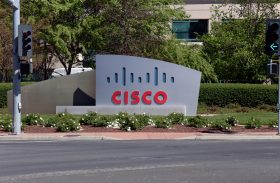Cisco Cites SD-WAN in Tech Earnings Boost
Cisco earnings are always looked upon as a sort of litmus test for the enterprise technology markets. Cisco did its job this week, announcing strong fiscal first quarter results that lifted its stock price 5%, aiding a turnaround in tech shares during a period of extended volatility and unease.
Cisco's numbers were boosted by a surge in government spending, momentum behind software-defined wide-area-networking (SD-WAN) trend, and fatter margins. But in a challenging global macro economic environment, investors will be looking for signs that this newfound growth is sustainable and not simply the by product of a short-term bump in government spending or the benefits of the recent corporate tax cuts that have spurred technology spending.
Nonetheless, the results were impressive. Cisco shares on Thursday rose 5% after the company announced $0.75 in earnings per share (EPS) and $13.07 billion in revenue. Analysts had projected $0.72 in EPS and revenue of $12.87 billion, according to Thomson Reuters.
The 8% year-over-year in revenue is Cisco's best growth in years. Enterprise orders were up 15% in the quarter, compared with 11% in the prior quarter. The biggest boost came in public sector spending, with government orders up 8% compared with 1% in the prior quarter. Also, emerging markets were strong, growing 16% y/y compared with 12% in the previous period.
Revenue in Cisco's infrastructure platform unit, which includes the switches and routers business, rose 9 percent to $7.64 billion, topping expectation of $7.39 billion.
On the conference call, Cisco executives said they saw strength across all enterprise markets. They spoke about pricing power as well as the momentum behind the SD-WAN driving a refresh in branch-office networking and connectivity.
"As we all know, the WAN is undergoing an architectural transition to a software defined WAN to enable IT to rapidly respond to changing business needs in a digital and cloud world," said CEO Chuck Robbins on the conference call. "Our customers are driving this transition and looking to Cisco to help them make this shift. Our SD-WAN portfolio leverages our leading networking products, automation, and robust security architecture to enable greater flexibility, increased bandwidth, and lower costs."
Robbins also cited deals such as the $2.35 billion purchase of cybersecurity firm Duo Security as playing a role. Duo was acquired in August.
This led some Wall-street analysts to embrace the resurgent Cisco.
"Another quarter of positive results/guidance supports our view that the IT/networking environment for Cisco is very strong right now," wrote George Notter, an analyst with Jefferies and company. "Further, investor perceptions about the company as a “melting ice cube” fighting against workload migration, market share pressures, etc. are wrong. To the contrary -- as networks get more complex -- we think Cisco’s end-to-end network capabilities become increasingly strategic to Enterprise and Service Provider customers."
However, some analysts also question the euphoria following a year of corporate tax cuts and easy-to-beat year-over-year comparable numbers. MKM partners analyst Michael Genovese said one might question whether this past quarter represented some kind of "peak" in earnings and revenue momentum,
"We think +8% is an impressive number, but we also suspect it may be the peak since the y/y order comps become meaningfully tougher in the current quarter, wrote Genovese in a note to investors."
Right now, Cisco represents yet another data point in an earnings season that has been confusing, at best. Many other technology companies have missed earnings forecasts curing this technology earnings season.
For example, Red Hat Software missed earnings in September before it was announced that IBM was buying it for $34 billion. This week, chip maker NVDIA had a huge earnings miss and semiconductor equipment supplier Applied Materials (AMAT) also announced disappointing results. Many consider the semiconductor sector to be an early-warning sign in tech because chips supply so many markets.












